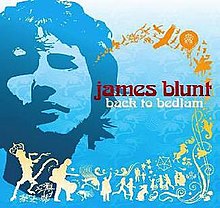Back to Bedlam
| Back to Bedlam | ||||
|---|---|---|---|---|

Album cover
|
||||
| Studio album by James Blunt | ||||
| Released | 11 October 2004 | |||
| Recorded | 2003 | |||
| Genre | ||||
| Length | 39:28 | |||
| Label | Atlantic, Custard, RCA | |||
| Producer | Tom Rothrock, Linda Perry | |||
| James Blunt chronology | ||||
|
||||
| Singles from Back to Bedlam | ||||
|
||||
| Alternative cover | ||||

2005 reissue cover
|
||||
| Professional ratings | |
|---|---|
| Review scores | |
| Source | Rating |
| AllMusic | |
| Common Sense Media | |
| Q | |
| BBC Collective | |
| IndieLondon | Positive |
| RocknWorld | |
| About.com | 8.6/10 |
| Slant Magazine | |
| Relevant | Positive |
Back to Bedlam is the debut studio album by English singer-songwriter James Blunt. It was released on 11 October 2004 through Atlantic Records. It is named after the infamous psychiatric institution of Bethlem Royal Hospital, which is commonly known as Bedlam.
The album was met with universal acclaim from music critics, who praised Blunt's voice and songwriting skills. Initially lingering in the lower regions of the UK Albums Chart in its first few months of release, it became a major international success after its third single, "You're Beautiful", was a huge hit worldwide in the Summer of 2005. Back to Bedlam was the highest-selling album of 2005 in the UK, with over 2.4 million copies sold. By December 2009, the album had been certified 10× Platinum by the British Phonographic Industry for sales of over 3 million, making it the best-selling album of the 2000s in the UK. In 2011, it was overtaken by the Amy Winehouse's Back to Black as the best-selling album of the 21st century in the UK.Back to Bedlam currently ranks as the 16th best-selling album in UK chart history. As of 2017, it has sold 3.33 million copies in the UK and over 11 million copies worldwide.
Blunt had piano and violin lessons as a child, but his first significant exposure to popular music was at Harrow School. There, he was introduced to the guitar by a fellow student, and started playing the instrument and writing songs at age 14. At University of Bristol, his undergraduate thesis was The Commodification of Image – Production of a Pop Idol; one of his main references for the thesis was sociologist and rock critic, Simon Frith, chairman of the Mercury Music Prize panel of judges since 1992.
...
Wikipedia
